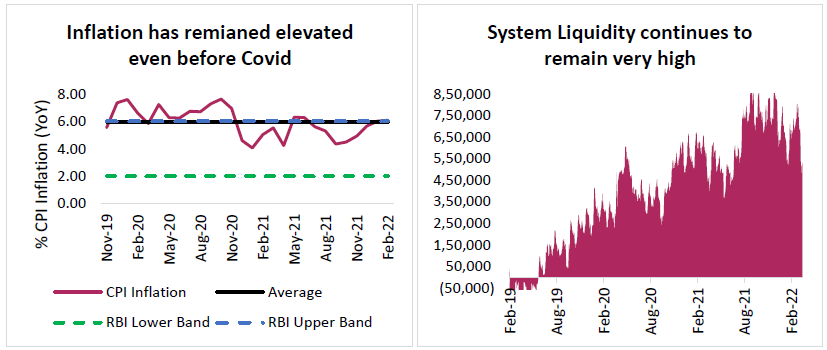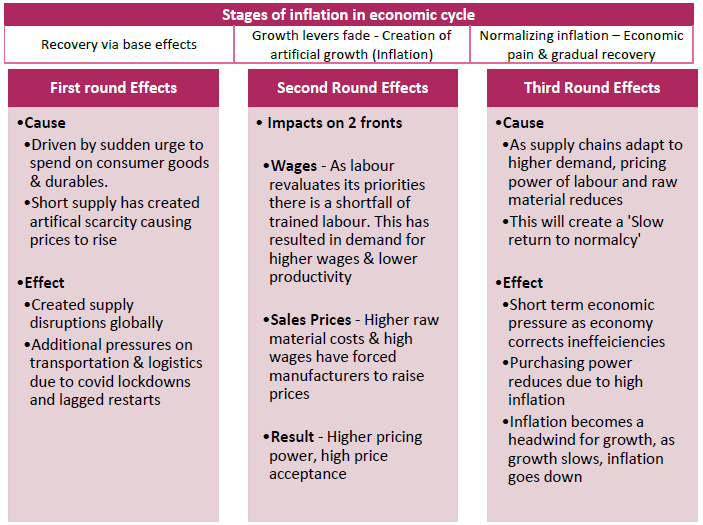Why elevated inflation is not good for India
Mutual Fund
What is CPI Inflation?
CPI inflation is an economic indicator which is the most widely used measure of inflation in the country. It can also be viewed as a proxy of the effectiveness of monetary policy set by the RBI. The mandate of the RBI is to maintain CPI inflation at 4% with a band of ±2%.
Inflation @6% – What does it mean for the economy?
Inflation for the last 2.5 years (to February 2022), has averaged close to 6%. This is even before COVID began. A belligerently high inflation number points to significant bottlenecks hampering growth. While the government continues to strive for ease of business and pave the way for growth, the current framework has been strangling real growth at closer to 5% levels before COVID struck. The past 2 Years Real GDP growth has cratered to 1% CAGR. With inflation at 6%, nominal GDP (Real GDP + Inflation) looks optically strong at 7% but point to an economy overheating. If we were to continue on this path, there could be serious repercussions, even stagflation.

Source: Bloomberg, Axis MF Research. Data as of 31st March 2022
One aspect of this heightened inflation could be linked to the lag effect of RBI policy. In the aftermath of the Covid outbreak, the RBI flooded the markets with low cost liquidity aimed at supporting the economy as its crashed into recession territory. Even as the economy has recovered, system liquidity is yet to be normalized adding to latent inflationary pressures. Given that monetary policy especially liquidity works with a lag, normalizing liquidity quickly and fixing inflation is the need of the hour.
Stages of Inflation
The story of inflation can be illustrated in 3 phases. Story of 2021 can be characterised as Impulse inflation. The stages of inflation can also project how inflation affects the health of the economy. Higher the inflation, Longer the impact of inflation on future growth. The impacts of high inflation are likely to play out in 2022 & 2023.
Monetary policy plays a key role in accelerating/slowing inflation. Policy makers use high frequency indicators in the economy to determine changes in an economic cycle to alleviate the pressures of inflation. Too much or too little inflation are bad for economic growth

Source: Axis MF Research
What is RBI doing?
The RBI has done complete U-turn in policy in its latest monetary policy. The focus has shifted from growth to inflation targeting, a necessary course correction. The new path charts out a return to pre-pandemic monetary policy – First, ensure system liquidity goes back to neutral from the current Rs. 3-4 lakh Cr net liquidity position. Second, narrow the corridor between MSF and LAF to 50bps from the current 90 bps and third, eventually to raise the repo rate in a calibrated manner.
RBI’s stated inflation target is 4%±2%. However, the 3-year average, including the RBI’s projected inflation for next year, is significantly higher at 5.8%. This is a significant blow to the credibility of the RBI, in essence confirming our stance that the RBI is now behind the policy curve. Dr. Michael Patra (Dy Governor of the RBI), commented that the target of the MPC will be to maintain positive real rates. Which implies that overnight rates now have to move 100 bps+ given the current state of inflation.
What should investors do?
Investors looking to allocate to debt strategies could consider fund segments with lower duration profiles and use target maturity strategies to gradually lock in incrementally higher rates over the next 6-12 months. To reiterate, bond yields are likely to see increased volatility and hence investors should remain vigilant in their allocations.
Disclaimer
Source of Data: Axis MF Research, Bloomberg.
This document represents the views of Axis Asset Management Co. Ltd. and must not be taken as the basis for an investment decision. Neither Axis Mutual Fund, Axis Mutual Fund Trustee Limited nor Axis Asset Management Company Limited, its Directors or associates shall be liable for any damages including lost revenue or lost profits that may arise from the use of the information contained herein. No representation or warranty is made as to the accuracy, completeness or fairness of the information and opinions contained herein. The material is prepared for general communication and should not be treated as research report. The data used in this material is obtained by Axis AMC from the sources which it considers reliable.
While utmost care has been exercised while preparing this document, Axis AMC does not warrant the completeness or accuracy of the information and disclaims all liabilities, losses and damages arising out of the use of this information. Investors are requested to consult their financial, tax and other advisors before taking any investment decision(s). The AMC reserves the right to make modifications and alterations to this statement as may be required from time to time.
Axis Mutual Fund has been established as a Trust under the Indian Trusts Act, 1882, sponsored by Axis Bank Ltd. (liability restricted to Rs. 1 Lakh). Trustee: Axis Mutual Fund Trustee Ltd. Investment Manager: Axis Asset Management Co. Ltd. (the AMC) Risk Factors: Axis Bank Limited is not liable or responsible for any loss or shortfall resulting from the operation of the scheme.
(Mutual Fund investments are subject to market risks, read all scheme related documents carefully.)
MUTUAL FUND TOOLS & CALCULATORS
Recent News
-
Mr. Navneet Munot's 'Person of the Year 2025'
Dec 31, 2025
-
The Wealth Company Mutual Fund Receives SEBI Approval to Launch Specialized Investment Fund SIF
Nov 26, 2025
-
Axis Mutual Fund Launches Axis Multi Asset Active FoF Fund of Fund: A One Stop Solution for Dynamic Asset Allocation
Nov 21, 2025
-
The Wealth Company Mutual Fund makes record debut with four active NFOs, garners close to Rs 2000CR
Oct 29, 2025
-
Axis MF Launches Axis Income Plus Arbitrage Passive FOF
Oct 28, 2025







